Habitat Cardigan |
||||
 |
 |
|||
Knitted jacket with collar, in 1 strand DROPS Fabel and 2 strands DROPS Brushed Alpaca Silk. Sizes S - XXXL.
DROPS 227-15 |
||||
|
------------------------------------------------------- EXPLANATIONS FOR THE PATTERN: ------------------------------------------------------- RIDGE/GARTER STITCH (worked back and forth): Knit all rows. 1 ridge = knit 2 rows. DECREASE TIP (evenly spaced): To work out how to decrease evenly, count the total number of stitches on needle (e.g. 75 stitches) minus the edge stitches (e.g. 2 stitches) and divide the remaining stitches by the number of decreases to be made (e.g. 20) = 3.7. In this example decrease by knitting together alternately each 2nd and 3rd stitch and each 3rd and 4th stitch (approx.). Do not decrease the edge stitches. INCREASE TIP (for sleeves): All increases are worked from the right side! Work 1 edge stitch, 1 yarn over, work until there is 1 stitch left, 1 yarn over and 1 edge stitch. On the next row purl the yarn overs twisted to avoid holes. CASTING-OFF TIP: To avoid the cast-off edge being tight you can cast off with a larger size needle. If the edge is still tight, make 1 yarn over after approx. each 4th stitch at the same time as casting off; the yarn overs are cast off as normal stitches. BUTTONHOLES (bottom up): Work the buttonholes on the right band. 1 BUTTONHOLE = knit together the 3rd and 4th stitch from the edge and make 1 yarn over. On the next row knit the yarn over to leave a hole. Work buttonholes when the piece measures: S: 15, 24, 33, 42 and 50 cm. M: 16, 25, 34, 43 and 52 cm. L: 14, 22, 30, 38, 45 and 52 cm. XL: 14, 22, 30, 38, 46 and 54 cm. XXL: 14, 22, 30, 38, 46 and 54 cm. XXXL: 14, 23, 32, 40, 48 and 56 cm. ------------------------------------------------------- START THE PIECE HERE: ------------------------------------------------------- JACKET – SHORT OVERVIEW OF THE PIECE: The piece is worked back and forth in sections, bottom up and then sewn together. The collar is worked to finish. BACK PIECE: Cast on 69-75-81-87-97-107 stitches with circular needle size 6 mm and 1 strand DROPS Fabel and 2 strands DROPS Brushed Alpaca Silk (= 3 strands). Purl 1 row from the wrong side, then work as follows: 1 edge stitch in GARTER STITCH – read description above, rib (knit 1, purl 1) until there are 2 stitches left, knit 1 and 1 edge stitch in garter stitch. Continue this rib back and forth for 12 cm. Knit 1 row from the right side where you decrease 18-20-22-22-26-28 stitches evenly spaced – read DECREASE TIP, and cast on 1 new stitch at the end of the row = 52-56-60-66-72-80 stitches. Change to circular needle size 8 mm. Purl 1 row from the wrong side and cast on 1 new stitch at the end of the row = 53-57-61-67-73-81 stitches. Continue with stocking stitch and 1 edge stitch in garter stitch on each side. REMEMBER THE KNITTING TENSION! When the piece measures 41-42-43-44-45-46 cm, cast off 1-1-2-4-6-8 stitches at the beginning of the next 2 rows for the armholes = 51-55-57-59-61-65 stitches. Continue with stocking stitch and 1 edge stitch in garter stitch on each side. When the piece measures 58-60-62-64-66-68 cm, cast off the middle 15-15-17-17-19-19 stitches for the neck and each shoulder is finished separately. Continue with stocking stitch and 1 edge stitch in garter stitch on each side, and cast off 1 stitch on the next row from the neck = 17-19-19-20-20-22 stitches on the shoulder. Continue working until the piece measures 60-62-64-66-68-70 cm. Cast off with knit from the right side. Work the other shoulder in the same way. RIGHT FRONT PIECE: Cast on 39-43-45-49-53-59 stitches (including 5 band stitches towards mid-front), with circular needle size 6 mm and 1 strand DROPS Fabel and 2 strands DROPS Brushed Alpaca Silk (= 3 strands). Purl 1 row from the wrong side, then work as follows from the right side: 5 band stitches in garter stitch, rib (knit 1, purl 1) until there are 2 stitches left, knit 1 and 1 edge stitch in garter stitch. Continue this rib back and forth for 12 cm. Knit 1 row from the right side where you decrease 9-11-11-12-13-15 stitches evenly spaced – remember DECREASE TIP, and cast on 1 new stitch at the end of the row = 31-33-35-38-41-45 stitches. Change to circular needle size 8 mm. Purl 1 row from the wrong side (band and edge stitches in garter stitch). Continue with stocking stitch, the 5 band stitches towards mid-front and 1 edge stitch in garter stitch towards the side. Remember the BUTTONHOLES on the band – read description above. When the piece measures 41-42-43-44-45-46 cm, cast off 1-1-2-4-6-8 stitches for the armhole at the beginning of the next row from the wrong side = 30-32-33-34-35-37 stitches. When the piece measures 52-54-54-56-56-58 cm and the next row is from the right side, place the first 9-9-10-10-11-11 stitches on a thread for the neck, working the stitches first to avoid having to cut the strand. Then cast off at the beginning of each row from the neck as follows: 1 stitch 4 times = 17-19-19-20-20-22 stitches on the shoulder. Continue working until the piece measures 60-62-64-66-68-70 cm. Cast off with knit from the right side. LEFT FRONT PIECE: Cast on 39-43-45-49-53-59 stitches (including 5 band stitches towards mid-front), with circular needle size 6 mm and 1 strand DROPS Fabel and 2 strands DROPS Brushed Alpaca Silk (= 3 strands). Purl 1 row from the wrong side, then work as follows from the right side: 1 edge stitch in garter stitch, rib (knit 1, purl 1) until there are 6 stitches left, knit 1 and 5 band stitches in garter stitch. Continue this rib back and forth for 12 cm. Knit 1 row from the right side where you decrease 9-11-11-12-13-15 stitches evenly spaced = 30-32-34-37-40-44 stitches. Change to circular needle size 8 mm. Purl 1 row from the wrong side (band in garter stitch) and cast on 1 stitch at the end of the row = 31-33-35-38-41-45 stitches. Continue with stocking stitch and the 5 band stitches towards mid-front and 1 edge stitch in garter stitch towards the side. When the piece measures 41-42-43-44-45-46 cm, cast off 1-1-2-4-6-8 stitches for the armhole at the beginning of the next row from the right side = 30-32-33-34-35-37 stitches. When the piece measures 52-54-54-56-56-58 cm and the next row is from the right side, work until there are 9-9-10-10-11-11 stitches left and place these stitches on a thread for the neck. Then cast off at the beginning of each row from the neck as follows: 1 stitch 4 times = 17-19-19-20-20-22 stitches on the shoulder. Continue working until the piece measures 60-62-64-66-68-70 cm. Cast off with knit from the right side. SLEEVES: Cast on 44-44-46-46-50-50 stitches with circular needle size 6 mm and 1 strand DROPS Fabel and 2 strands DROPS Brushed Alpaca Silk (= 3 strands). Purl 1 row from the wrong side, then work as follows from the right side: 1 edge stitch in garter stitch, rib (knit 1, purl 1) until there is 1 stitch left, 1 edge stitch in garter stitch. When the rib measures 12 cm, knit 1 row from the right side where you decrease 10-10-10-10-12-12 stitches evenly spaced = 34-34-36-36-38-38 stitches. Change to circular needle size 8 mm. Continue with stocking stitch and 1 edge stitch in garter stitch on each side. When the sleeve measures 14 cm, increase 1 stitch on each side – read INCREASE TIP. Increase like this every 8-6½-6-5-4½-3½ cm a total of 5-6-6-7-7-8 times = 44-46-48-50-52-54 stitches. Continue working until the sleeve measures 49-49-48-46-45-43 cm, or to desired length (approx. 1-1-2-4-5-7 cm left for the sleeve cap). Insert 1 marker on each side – they mark the bottom of the armhole and are used when sewing the sleeves to the body. Continue working until the sleeve measures 50 cm in all sizes. Cast off with knit from the right side. Work the other sleeve in the same way. ASSEMBLY: Sew the shoulder seams inside the cast-off edge. Sew in the sleeves, inside the 1 edge stitch along the armholes and the cast-off edge on the sleeve cap. Sew together the bottoms of the armholes – the markers on the sleeve should match the sides of the body – see sketch. Sew the sleeve and side seams in one go inside the 1 edge stitch, leaving a 12 cm split at the bottom of each side seam. COLLAR: Start from the right side with circular needle size 6 mm and 1 strand DROPS Fabel and 2 strands DROPS Brushed Alpaca Silk (= 3 strands). Place the 9-9-10-10-11-11 stitches from the thread on the right front piece on the needle, knit up 77-77-83-83-89-89 stitches inside the 1 edge stitch around the neck and place the 9-9-10-10-11-11 stitches from the left front piece on the needle = 95-95-103-103-111-111 stitches. Work rib from the wrong side as follows: 1 edge stitch in garter stitch, rib (purl 1 knit 1) until there are 2 stitches left, purl 1 and 1 edge stitch in garter stitch. Continue this rib back and forth for 4 cm. Work the next row from the right side as follows: Work the first 27 stitches as before, then work 3 stitches in the next knitted stitch as follows: Knit 1 but do not slip it from the left needle, make 1 yarn over, knit 1 in the same stitch and slip the stitch from the left needle (= 2 stitches increased), * work the next 7 stitches, work 3 stitches in the next knitted stitch (in the same way as before) *, work from *-* until there are 27 stitches left and work these stitches as before = 107-107-117-117-127-127 stitches. On the next row work the yarn overs twisted and into the rib. Continue the new rib until the collar measures 13 cm. Cast off with knit over knit and purl over purl – read CASTING-OFF TIP. |
||||
Diagram explanations |
||||
|
||||

|
||||
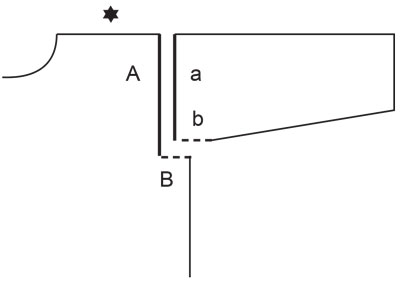
|
||||
|
Have you made this or any other of our designs? Tag your pictures in social media with #dropsdesign so we can see them! Do you need help with this pattern?You'll find tutorial videos, a Comments/Questions area and more by visiting the pattern on garnstudio.com. © 1982-2024 DROPS Design A/S. We reserve all rights. This document, including all its sub-sections, has copyrights. Read more about what you can do with our patterns at the bottom of each pattern on our site. |
||||









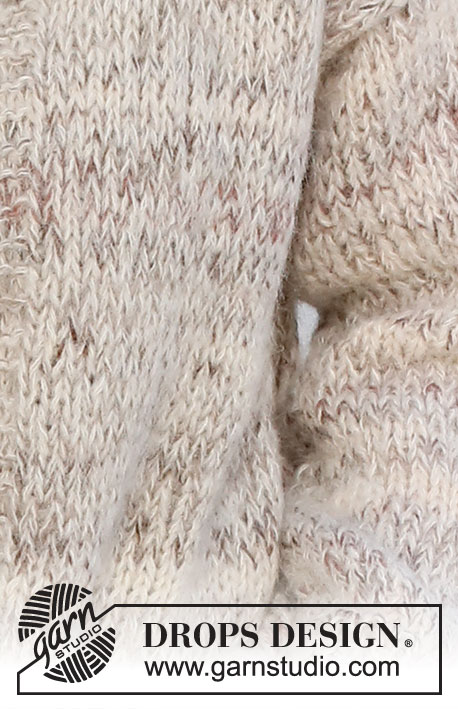


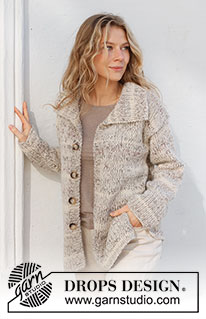






















































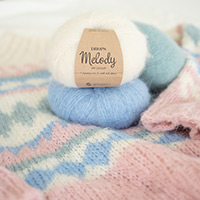
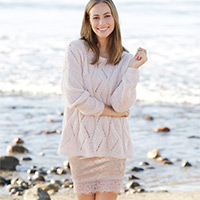
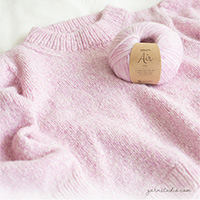
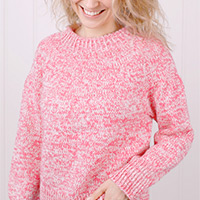
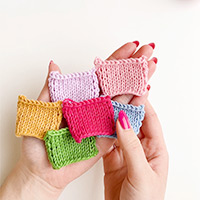
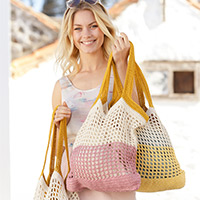
Comments / Questions (37)
Hi, can I knit this model with 1 strand Fabel and 1 strand Air with needles 8 mm? It will fit the same measures that you have?
14.01.2022 - 20:52DROPS Design answered:
Dear Andreea, you should work with 2 strands of Air, since you need 2 strands of Group C yarns, plus the strand of Fabel. In any case, you should work a swatch to see if the gauge will fit the one needed in the pattern. Happy knitting!
16.01.2022 - 21:34Gaat dit patroon er nog komen of hoe zit het volgens jullie zou her er al op staan maar dat is niet zo
01.11.2021 - 11:35DROPS Design answered:
Dag Yvonne,
Het patroon is inmiddels geplaatst. Ook in het Nederlands. Veel breiplezier!
02.11.2021 - 17:14Why don’t we have instructions in French. I am a québécoise, à French Canadian, Pourquoi au Canada, n’avons nous pas les instructions en français. Si nous voulons acheter nous devons convertir et traduire. Merci de votre aide
30.10.2021 - 20:14DROPS Design answered:
Dear Ginette, our translators working continiously to get all the patterns translated as soon as possible, but we are all humans, sometimes a pattern just gets translated a bit later. However, this cardigan is actually available in french, just open the roll down menue below the picture and select the french version. Happy Knitting!
30.10.2021 - 21:05Net als Yvonne Smeijsters wacht ik ook op dit patroon, dat inderdaad nog niet op de site staat. Jullie geven aan dat het onder nummer 227-15 op de site staat maar dan klopt dit nummer niet. Graag verduidelijking, is het patroon beschikbaar, zo ja, onder welk nummer, zo nee, wanneer komt het beschikbaar?
13.10.2021 - 15:50De beschrijving staat er nog niet op er kan niets afgedrukt worden
13.10.2021 - 08:33Wanneer komt het patroon uit.
12.10.2021 - 18:44DROPS Design answered:
Dag Yvonne,
Het patroon staat al op de site, dus je kunt hem afdrukken. Al onze patronen zijn gratis af te drukken via de knop 'Afdrukken' onder de materialenlijst. Klik op de knop 'Afdrukken' en dan op 'Patroon'. In het pop-up venster dat vervolgens in beeld komt klik je rechts boven op de link 'Het patroon afdrukken'.
13.10.2021 - 07:41Kun u mij zeggen wanneer dit patroon beschikbaar komt, en wat wordt de stekenproef? Alvast dank.
12.10.2021 - 13:08Postanowiłam zrobić sobie taki sweter, z innej włóczki o innej grubości. 1 . dlaczego po zrobieniu ściągacza trzeba zmniejszyć ilość oczek na drucie aż o 22 (chodzi na razie o tył, rozmiar L). Zwykle po zrobieniu ściągacza dodaje się oczka w jego ostatnim rzędzie. 2. Dlaczego na schemacie (rysunku) nie uwzględniono podkroju tyłu? Z opisu wynika, ze ma mieć 2 cm, i że po wykonaniu tych 2 cm, trzeba zakończyć wszystkie oczka ramion w tym samym rzędzie?
02.10.2021 - 19:42DROPS Design answered:
Witaj Małgosiu, 1. dodajemy oczka, ale wtedy gdy przerabiamy od góry do dołu, tuż przed ściągaczem. Przerabiając od dołu do góry zamykamy oczka za ściągaczem, po to, aby ściągacz miał taką samą szerokość jak dalsza część swetra. 2. nie jest to widoczne na rysunku, ale przerabiaj tak jak jest w opisie. Pozdrawiamy!
03.10.2021 - 21:38Finns det en måttskiss?
23.09.2021 - 20:33DROPS Design answered:
Hej Amanda. Ja, du hittar den längst ner på mönstret. Mvh DROPS Design
24.09.2021 - 08:33Hoop dat het patroon snel uitkomt zou hem willen maken
23.09.2021 - 09:43